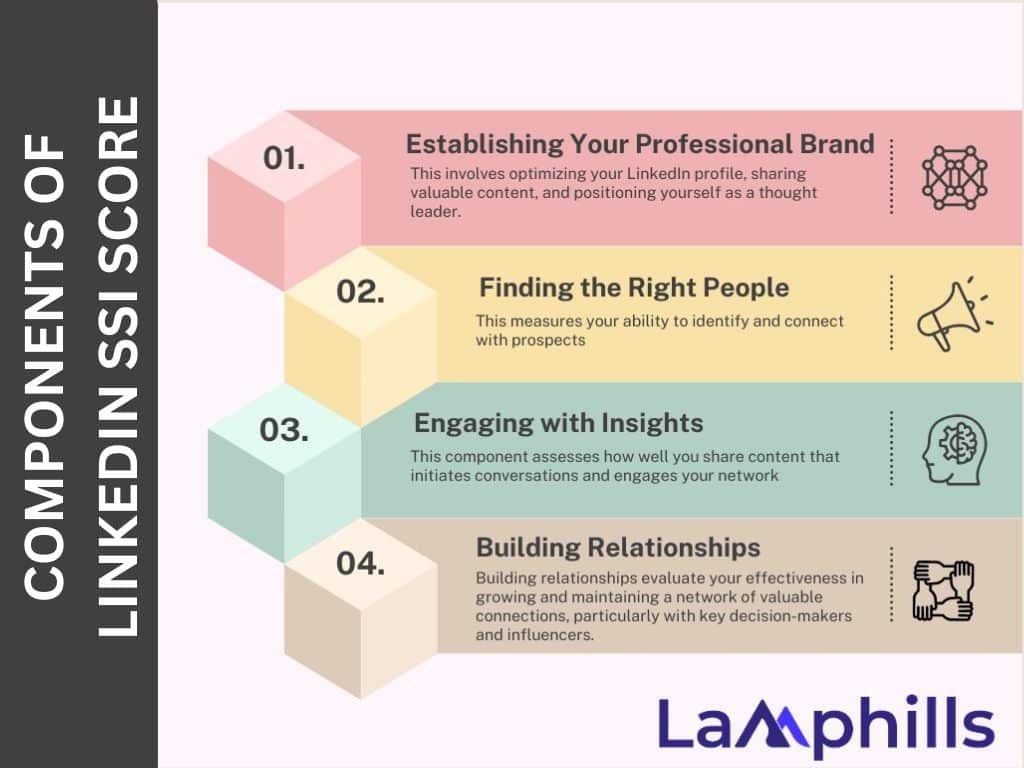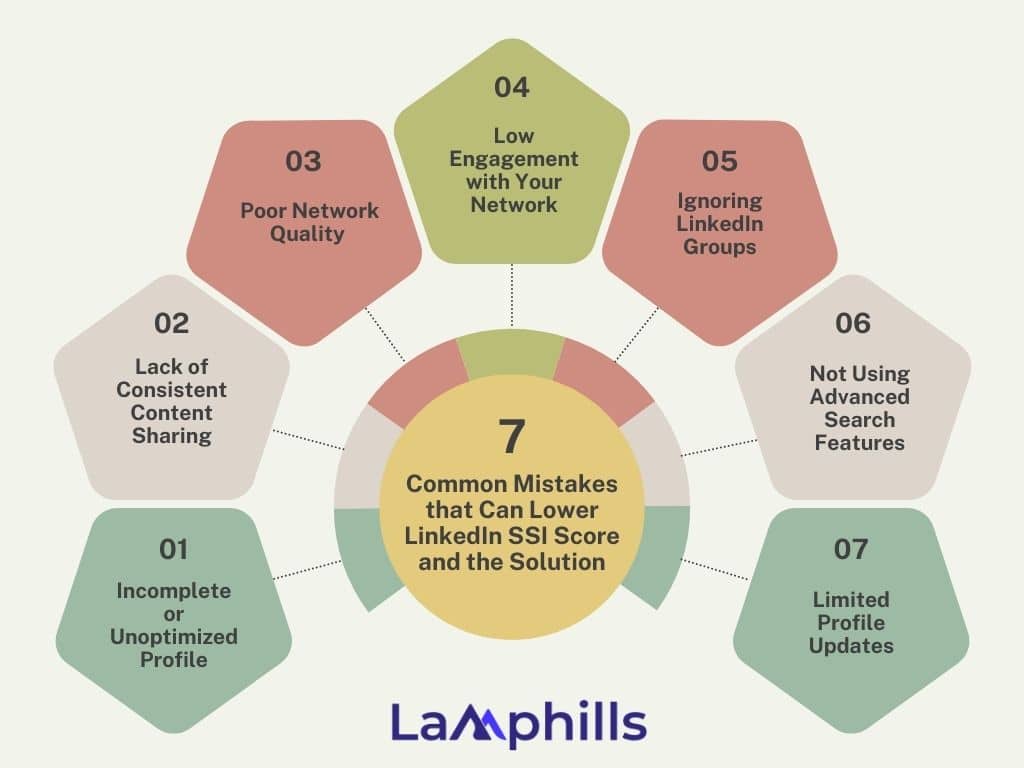With more than one billion users from across the globe, you’ll agree that LinkedIn is a powerful platform for building strategic relationships and advancing careers. Another amazing thing about this platform is the metric it uses to measure users’ social selling index—the LinkedIn SSI score. The social selling index score sets LinkedIn apart from other social platforms as it targets users’ effective use of the platform. At this point, I’m tempted to ask: What is your SSI score? Are you fully maximizing the LinkedIn platform? This article delves deep into the LinkedIn SSI score, why it matters, and how you can improve it to boost your professional brand and network.
Key Points
- The Social Selling Index (SSI) score is a metric developed by LinkedIn to measure how users leverage their LinkedIn presence for social selling.
- Social selling is all about using social media platforms to find, connect with, understand, and nurture sales prospects.
- A score above 70 indicates that you effectively use LinkedIn to network, build your brand, and engage with your professional community. A score of 50–70 suggests you are active on LinkedIn and making good use of its features, but there may be areas for improvement.
- The LinkedIn SSI score is important because it positions you for greater professional success and opportunities in terms of networking, personal branding, and sales.
- LinkedIn SSI scores and social media influence scores share common goals in measuring online influence and engagement, however, they differ in scope, components, and the specific audience they cater to.
Understanding LinkedIn SSI Score
LinkedIn is more than a social media platform where people make new friends. It’s a professional platform designed to build strategic relationships, foster career development, and achieve personal and organizational goals. To achieve this goal, LinkedIn developed a metric that measures users’ ability to maximize the platform and gauge success. The platform has an SSI score for every registered user based on four key components.
A high score means you’re a thought leader in your field and an expert who understands how to maximize the platform. On the other hand, a low score means you’re yet to maximize its uses. While many think this counts for nothing, you should leverage it if you’re a salesperson because it’s a powerful tool that helps you achieve personal and business goals.
The LinkedIn SSI score is a powerful tool for anyone looking to maximize their effectiveness on LinkedIn. First, you must understand and improve each component; it’ll enhance your professional brand, expand your network, and drive more meaningful engagements over time. My journey with LinkedIn SSI has boosted my professional presence while opening doors to numerous opportunities.
Read Also: A Step-by-Step Guide to Building a Comprehensive LinkedIn Content Strategy
LinkedIn SSI Score and What It’s About
The SSI score, also known as the Social Selling Index (SSI) score, is a metric developed by LinkedIn to measure how users leverage their LinkedIn presence for social selling. It ranges from 0 to 100 and is broken into four key components. These four components are the bedrock of social selling and are rated out of 25. To be sure you understand what this is about, let’s first understand what social selling is.
What Is Social Selling?
Social selling means using social media platforms to find, connect with, understand, and nurture sales prospects. It leverages social networks to build and maintain relationships with potential clients. It facilitates the sales process through personalized engagement rather than traditional cold calls or direct selling methods. That’s what LinkedIn aims to achieve by introducing the SSI score metrics.
Components of LinkedIn SSI Score

When I first learned about the SSI score, I saw it as a pathway to enhance my LinkedIn strategy. Here’s the sincere truth: focusing on each component will systematically improve your presence and effectiveness on the platform. The four components of the LinkedIn SSI score are: Establishing Your Professional Brand, Finding the Right People, Engaging with Insights, and Building Relationships. To be sure you understand this, let’s take them one after the other:
#1. Establishing Your Professional Brand
This involves optimizing your LinkedIn profile, sharing valuable content, and positioning yourself as a thought leader. Well, you can’t possibly achieve this without a complete customer-centric profile. I started by refining my LinkedIn profile. This involved:
- Professional Photo and Headline: A clear, professional photo and a headline that reflected my expertise and value proposition.
- About Section: Here, I focused on crafting an engaging summary that highlights my experience, skills, and what I bring to the table.
- Content Sharing: Regularly posting articles, insights, and updates related to my industry.
#2. Finding the Right People
This measures your ability to identify and connect with prospects. LinkedIn isn’t like Facebook, Instagram, or TikTok, where just about anyone can follow you, and it’ll count. You just have to follow the right people, and the right people have to follow you. Sometimes, you’ll have to find them with LinkedIn’s search tools and filters. For me, LinkedIn’s advanced search features are one of my most used features. I used this to find and connect with potential clients and industry leaders. You can also use it to join relevant groups or participate in discussions to expand your network.
#3. Engaging with Insights
This component assesses how well you share content that initiates conversations and engages your network. It involves liking, commenting, and sharing industry-related posts. If you’re consistent with this, sharing insightful content might become a daily habit. You can start by curating articles, sharing your blog posts, and engaging with posts from your network. This increased my visibility and also established me as a knowledgeable professional in my field.
#4. Building Relationships
Building relationships evaluates your effectiveness in growing and maintaining a network of valuable connections, particularly with key decision-makers and influencers. Make it a point to interact with your connections through comments, direct messages, and providing value through introductions and recommendations.
What is a Good Score for LinkedIn?
A good LinkedIn score depends on your industry and goals. For instance, industry and thought leaders are expected to have an SSI score of 75 or above to be regarded as experts. A score above 70 indicates that you effectively use LinkedIn to network, build your brand, and engage with your professional community. A score of 50–70 suggests you are active on LinkedIn and making good use of its features, but there may be areas for improvement.
Why is LinkedIn SSI Score Important?
The LinkedIn SSI score is important because it positions you for greater professional success and opportunities in terms of networking, personal branding, and sales, ultimately leading to great results, as seen below:
#1. It Measures Social Selling Effectiveness
The SSI score quantifies your effectiveness in using LinkedIn for social selling. It provides a clear, numerical representation of how well you build your professional brand, find and engage with the right people, and maintain relationships. This helps professionals identify strengths and areas for improvement in their social selling strategies.
#2. Enhances Personal Branding
A high SSI score indicates that you have a well-optimized LinkedIn profile. It also means you actively share relevant, and valuable content. First, it enhances your brand and establishes you as a thought leader in your industry. Secondly, it signals to your network that you are knowledgeable and engaged, increasing your credibility and visibility.
#3. Improves Networking Opportunities
Having a higher SSI score often correlates with better networking opportunities. First, it shows that you are effective at finding and connecting with the right people. Secondly, it proves you engage in meaningful conversations while building strong professional relationships. This can lead to more connection requests, profile views, and engagement from industry peers and potential clients.
#4. Boosts Sales Performance
For sales professionals, a high SSI score is often linked to improved sales performance. LinkedIn’s data indicates that those with a high SSI score tend to achieve higher sales quotas and close more deals than those with lower scores. The score encourages best practices in social selling, such as personalized engagement and thoughtful content sharing, which can directly impact sales outcomes.
#5. Provides Actionable Insights
The SSI score breaks down into four components: establishing your professional brand, finding the right people, engaging with insights, and building relationships. Each provides specific insights into your LinkedIn activities, helping you understand what you’re doing well and where to focus your efforts. This targeted feedback is invaluable for continuously improving your social selling strategy.
#6. Increases Algorithmic Advantage
LinkedIn’s algorithm tends to favor users who actively engage with the platform and provide value to their network. A higher SSI score can enhance your visibility on the platform. Your posts and profile will be visible to a wider audience. This increased visibility can lead to more engagement, connections, and opportunities.
How to Improve LinkedIn SSI Score
Strategically build your career or achieve your personal and business goals by improving your SSI score. Over the years, research and personal experience have taught me that the following are the most strategic ways to improve your SSI score:
#1. Establish Your Professional Brand
While this point sounds like one of the key components of the SSI score, it focuses on optimizing your LinkedIn profile. Don’t just open a LinkedIn account; optimize it to be relevant and search-worthy in your industry. That way, you’ll connect with the right people. To optimize your profile, kindly do the following:
- Update your profile with a professional photo, a compelling headline, a detailed summary, and all relevant work experiences.
- Showcase your expertise by publishing articles, posts, and updates. This announces you as a thought leader or expert. You can use presentations, videos, and portfolio pieces to make your profile more dynamic and engaging.
- Post regularly you can go for at least one post per week to keep your network engaged.
- Curate valuable content by sharing relevant articles, infographics, and news that provide value to your connections.
#2. Find the Right People
Don’t just find people; make sure they are the right people. You can use filters to find prospects based on industry, job title, location, and more. Don’t forget to follow up after connecting by sending personalized messages to start conversations and build relationships.
#3. Engage with Insights
Engagement is another important metric. Always like, comment on, and share posts from your network. You can also follow influencers and companies that align with your industry.
#4. Build Relationships
One of the strategic ways I used to build relationships was by personalizing my connection requests. Most often, this is effective, especially when reaching out to top thought leaders in your industry or anyone who’ll help you achieve your goals. Another effective trick is making time to nurture existing relationships.
#4. Use LinkedIn Tools
Consider using Sales Navigator for advanced search capabilities and personalized insights. Regularly check your LinkedIn analytics to understand what content resonates most with your audience and adjust your strategy accordingly.
#5. Stay Active
You’ll have to stay active for your SSI score to improve. You can use a to-do list or get a content calendar to stay consistent on LinkedIn. This is because being an active user will boost your engagement, which helps keep your profile visible and your SSI score high.
How to Get Your LinkedIn Score
To find your LinkedIn Social Selling Index (SSI) score, follow these steps:
- Log in to LinkedIn: Using your browser, go to LinkedIn; and log into your account.
- Access the SSI Dashboard and View Your Score: Once on the SSI page, you will see your overall SSI score out of 100. Alternatively, you can go to the Social Selling Index page by typing https://www.linkedin.com/sales/ssi into your browser’s address bar to view your LinkedIn SSI score.
Lamphills’ Checklist for Tracking Your LinkedIn SSI Progress
Download Lamphills’ Checklist to Tracking Your LinkedIn SSI Progress
What Role Does Finding the Right People Play in the SSI Score?
Finding and connecting with the right people on LinkedIn can significantly improve your overall social selling strategy. This not only increases your network’s relevance but also boosts your professional brand and engagement on the platform. It accounts for 25 out of the total 100 points of SSI. It measures how you identify, connect with, and build relationships with relevant prospects on LinkedIn.
How Important is Engaging with Insights for My SSI Score?
Engaging with insights is important because it comprises 25% of the total SSI score. It measures how you engage with your network through relevant content, fostering meaningful interactions that can lead to stronger professional relationships and opportunities.
Can LinkedIn Premium Improve my SSI Score?
Yes, LinkedIn Premium can help improve your LinkedIn Social Selling Index (SSI) score in several ways because it offers advanced tools and features that facilitate better engagement, networking, and content sharing.
Are LinkedIn Certifications Useful for Boosting SSI Scores?
Yes, LinkedIn certifications can be useful for boosting your SSI score, particularly in the areas of establishing your professional brand and engaging with insights. In clearer terms, these certifications can enhance your profile, and demonstrate your expertise.
Is LinkedIn SSI Score Similar to Social Media Influence Scores?
LinkedIn SSI scores and social media influence scores share common goals in measuring online influence and engagement, however, they differ in scope, components, and the specific audience they cater to. The SSI score is focused on LinkedIn and is particularly useful for sales professionals looking to improve their social selling strategies. In contrast, social media influence scores provide a broader measure of influence across multiple platforms, which is useful for marketers and brands aiming to understand their overall social media impact.
Common Mistakes that Can Lower LinkedIn SSI Score and the Solution

The following are some of the common errors that can lower your SSI score and how to deal with these:
#1. Incomplete or Unoptimized Profile
An incomplete profile with missing sections like a profile picture, summary, experience, and skills reduces your credibility and visibility on LinkedIn. To ensure this doesn’t affect your SSI score, complete your profile.
#2. Lack of Consistent Content Sharing
Being inactive, or not sharing or engaging with content regularly reduces your visibility and the likelihood of engagement from your network. To avoid this, post relevant, high-quality content that adds value to your network. You can also engage with posts by liking, commenting, and sharing.
#3. Poor Network Quality
Connecting with a broad but irrelevant network can dilute the quality of your connections, making it harder to engage with the right people. To avoid this, focus on connecting with professionals relevant to your industry and goals. Use LinkedIn’s search filters to find and connect with the right people.
#4. Low Engagement with Your Network
Not interacting with your connections through messages, endorsements, or comments can weaken your relationships and reduce your SSI score. To avoid this, actively engage with your network by commenting on their posts, endorsing their skills, and sending personalized messages.
#5. Ignoring LinkedIn Groups
Failing to participate in LinkedIn groups reduces opportunities to share insights and engage with a broader audience. To avoid this, join relevant LinkedIn groups and participate by sharing content and engaging in discussions.
#6. Not Using Advanced Search Features
Not using LinkedIn’s advanced search features can limit your ability to find and connect with potential leads and relevant professionals. To avoid this, use LinkedIn’s advanced search filters to identify and connect with relevant professionals in your field.
#7. Limited Profile Updates
Infrequent updates to your profile can signal inactivity, reducing your visibility and engagement on the platform. Regularly update your profile to reflect new achievements, skills, and experiences to avoid this.
Others include:
- Lack of Personalization in Outreach
- Ignoring Analytics and Feedback
- Spamming and Over-Promotion
Platforms with Comparable Metrics to LinkedIn SSI Score
Other platforms with metrics similar to LinkedIn’s SSI score include:
- Twitter Analytics: Measures engagement, reach, and follower growth.
- Facebook Insights: Provides data on post reach, engagement, and audience demographics.
- Instagram Insights: Tracks engagement, follower growth, and post performance.
- Google Analytics: Offers detailed insights into website traffic, user behavior, and engagement.
Conclusion
To maximize the use of your LinkedIn account, you must understand and improve your LinkedIn SSI score. Besides, focusing on the components of the SSI score will enhance your professional brand, expand your network, and drive more meaningful engagements. With consistent effort and strategic use of LinkedIn’s tools, you can achieve a high SSI score and unlock numerous professional opportunities. Who knows, you might just become a thought leader on LinkedIn.
Related Articles
- How to Be a Social Media Manager for a Small Business With No Experience in 2024
- Threads Marketing 101: A Complete Guide to Boosting Your Campaigns
- Hiring a PPC Expert: What to Look For and How to Choose the Right One
- LinkedIn Social Media Strategy: A 7-Step Guide to Creating a Winning LinkedIn Social Media Strategy (+ Examples and Template)
- Top Social Media Advertising Metrics Every Marketer Should Track in 2024






